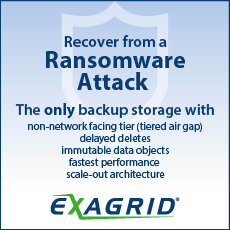Sandisk: Fiscal 3Q25 Financial Results
Revenue at $1.70 billion, down 10% sequentially, expecting next quarter at $1.75-1.85 billion
This is a Press Release edited by StorageNewsletter.com on May 8, 2025 at 2:02 pmNews Summary
-
Third quarter revenue was $1.70 billion, down 10% sequentially and above the guidance range.
-
Third quarter GAAP loss was $1.93 billion ($13.33 loss per share), including a $1.83 billion goodwill impairment charge. Third quarter Non-GAAP loss per share was $0.30.
-
Expect fiscal fourth quarter 2025 revenue to be in the range of $1.75 billion to $1.85 billion.
-
Expect Non-GAAP earnings (loss) per share to be in the range of ($0.10) to $0.15.
Sandisk Corporation reported fiscal third quarter financial results.
![]() “I’m pleased with our team’s execution in the first quarter as a standalone company. Sandisk’s innovation was reinforced, with a strong early ramp of BiCS 8, our latest technology engineered to deliver industry-leading performance, power efficiency, and density,” said David Goeckeler, CEO, Sandisk. “We have taken actions to reduce supply to match demand and commenced price increases this quarter. Our investment, supply management, and pricing strategies will remain focused on maximizing returns.“
“I’m pleased with our team’s execution in the first quarter as a standalone company. Sandisk’s innovation was reinforced, with a strong early ramp of BiCS 8, our latest technology engineered to deliver industry-leading performance, power efficiency, and density,” said David Goeckeler, CEO, Sandisk. “We have taken actions to reduce supply to match demand and commenced price increases this quarter. Our investment, supply management, and pricing strategies will remain focused on maximizing returns.“
Q3 2025 Financial Highlights
* Not a meaningful figure
End Market Summary
Business Outlook for Fiscal Fourth Quarter of 2025
(1) Non-GAAP gross margin guidance excludes stock-based compensation expense and expense for short term incentives granted in connection with the separation, totaling approximately $4 million to $6 million. The Company’s Non-GAAP operating expenses guidance excludes stock-based compensation expense and expense for short term incentives granted in connection with the separation, totaling approximately $45 million to $60 million. The Company’s Non-GAAP interest and other expenses, net guidance excludes the accretion of the present value discount on consideration receivable from the sale of an interest in a subsidiary, totaling approximately $2 million. In the aggregate, Non-GAAP diluted earnings (loss) per share guidance excludes these items totaling $47 million to $64 million. The timing and amount of these charges excluded from Non-GAAP gross margin, Non-GAAP operating expenses, Non-GAAP interest and other expenses, net, and Non-GAAP diluted earnings (loss) per share cannot be further allocated or quantified with certainty. Additionally, the timing and amount of additional charges the Company excludes from its Non-GAAP diluted earnings (loss) per share are dependent on the timing and determination of certain actions and cannot be reasonably predicted. Accordingly, full reconciliations of Non-GAAP gross margin, Non-GAAP operating expenses, Non-GAAP interest and other expenses, net, and Non-GAAP diluted earnings (loss) per share to the most directly comparable GAAP financial measures (gross margin, operating expenses, and diluted earnings (loss) per share, respectively) are not available without unreasonable effort.
(2) Non-GAAP tax expense is determined based on a Non-GAAP pre-tax income or loss. Our estimated Non-GAAP tax expense may differ from our GAAP tax expense (i) due to differences in the tax treatment of items excluded from our Non-GAAP net income or loss; (ii) due to the fact that our GAAP income tax expense or benefit recorded in any interim period is based on an estimated forecasted GAAP tax expense for the full year, excluding loss jurisdictions; and (iii) because our GAAP taxes recorded in any interim period are dependent on the timing and determination of certain GAAP operating expenses.
Basis of Presentation
On February 21, 2025, Sandisk Corporation completed its separation from Western Digital Corporation and became a standalone publicly traded company.
The Company’s financial and operating results after the separation are presented on a consolidated basis. For periods prior to the separation, the Company’s historical combined financial statements were prepared on a carve-out basis and were derived from WDC’s consolidated financial statements and accounting records and prepared as if the Company existed on a standalone basis. The financial statements for all periods presented, including the historical results of the Company prior to February 21, 2025, are now referred to as “Condensed Consolidated Financial Statements” and have been prepared in accordance with US generally accepted accounting principles (“GAAP”).
Investor Communications
The company held a investment community conference call to discuss results and the business outlook for the fiscal fourth quarter of 2025. An archived webcast of the conference can be accessed at investor.sandisk.com.
Forward-Looking Statements
This press release contains forward-looking statements within the meaning of federal securities laws, including statements regarding expectations for: the Company’s business outlook and operational and financial performance for the fiscal fourth quarter of 2025 and beyond; product developments and innovations; the performance and characteristics of the Company’s products; industry and supply conditions and dynamics; demand and market conditions for our products; and the Company’s capital investment and pricing strategies. These forward-looking statements are based on management’s current expectations and are subject to risks and uncertainties that could cause actual results to differ materially from those expressed or implied in the forward looking statements. The financial results for the Company’s fiscal third quarter ended March 28, 2025 included in this press release represent the most current information available to management. Actual results when disclosed in the Company’s Form 10-Q may differ from these results as a result of the completion of the Company’s financial closing procedures; final adjustments; completion of the review by the Company’s independent registered accounting firm; and other developments that may arise between now and the filing of the Company’s Form 10-Q. Other key risks and uncertainties that could cause actual results to differ materially from those expressed or implied in the forward-looking statements include: adverse changes in global or regional economic conditions, including the impact of evolving trade policies, tariff regimes and trade wars; volatility in demand for the Company’s products; pricing trends and fluctuations in ASPs inflation; changes in interest rates and a potential economic recession; future responses to and effects of global health crises; the impact of business and market conditions; the impact of competitive products and pricing; the Company’s development and introduction of products based on new technologies and management of technology transitions; risks associated with strategic initiatives, including restructurings, acquisitions, divestitures, cost saving measures and joint ventures; risks related to product defects; difficulties or delays in manufacturing or other supply chain disruptions; our reliance on strategic relationships with key partners, including Kioxia Corporation; hiring and retention of key employees; the Company’s level of debt and other financial obligations; changes to the Company’s relationships with key customers or consolidation among our customer base; compromise, damage or interruption from cybersecurity incidents or other data system security risks; our reliance on intellectual property; fluctuations in currency exchange rates; actions by competitors; risks associated with compliance with changing legal and regulatory requirements; future material impairments in the value of our goodwill and other long-lived assets; our ability to achieve some or all of the expected benefits of the separation from WDC; and other risks and uncertainties listed in the Company’s filings with the SEC (the “SEC”), including the Registration Statement on Form 10, initially filed with the SEC on November 25, 2024, as further amended thereafter and declared effective on January 31, 2025, and the company’s Quarterly Report on Form 10-Q for the quarter ended December 27, 2024, as initially filed with the SEC on March 7, 2025 and amended on March 17, 2025, to which your attention is directed. You should not place undue reliance on these forward-looking statements, which speak only as of the date hereof, and the Company undertakes no obligation to update or revise these forward-looking statements to reflect new information or events, except as required by law.
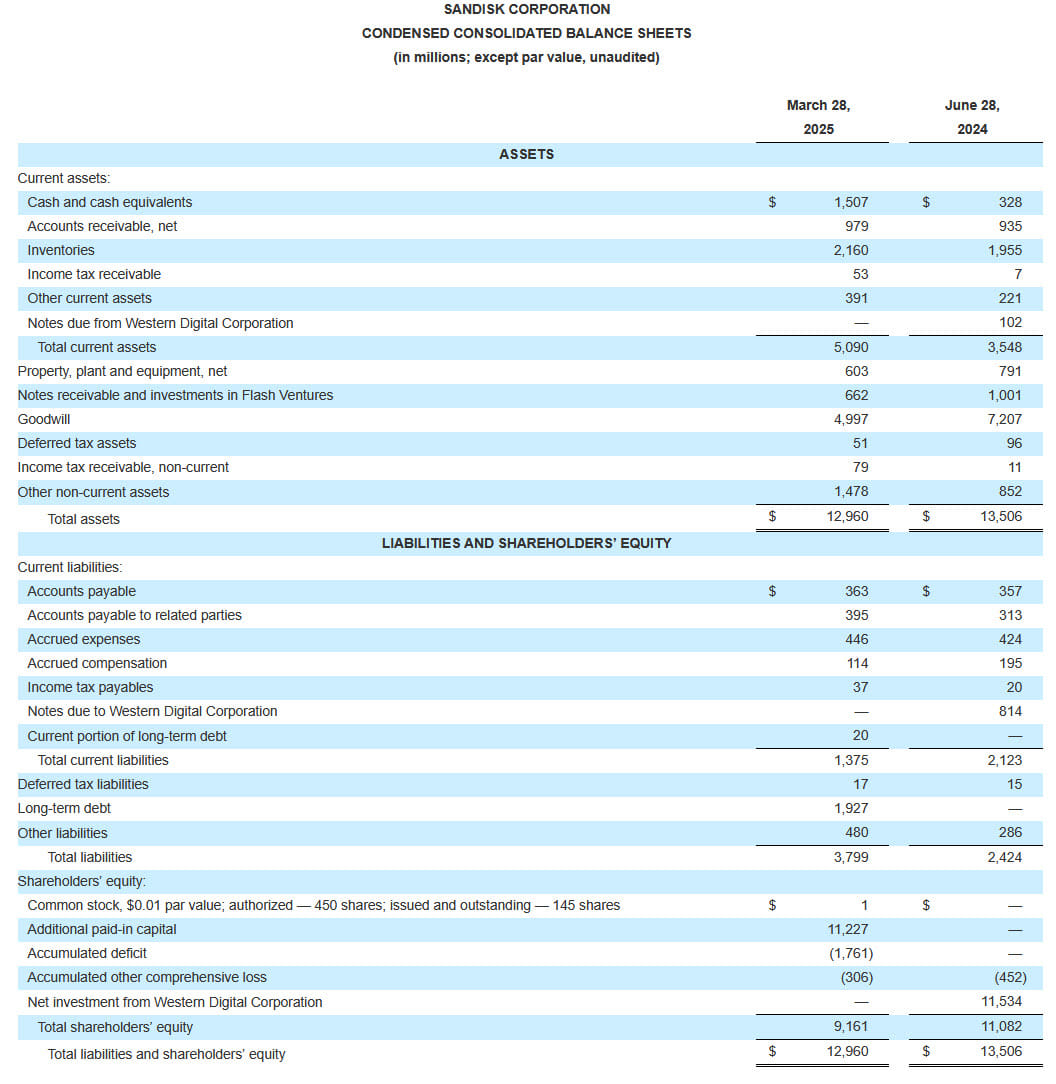
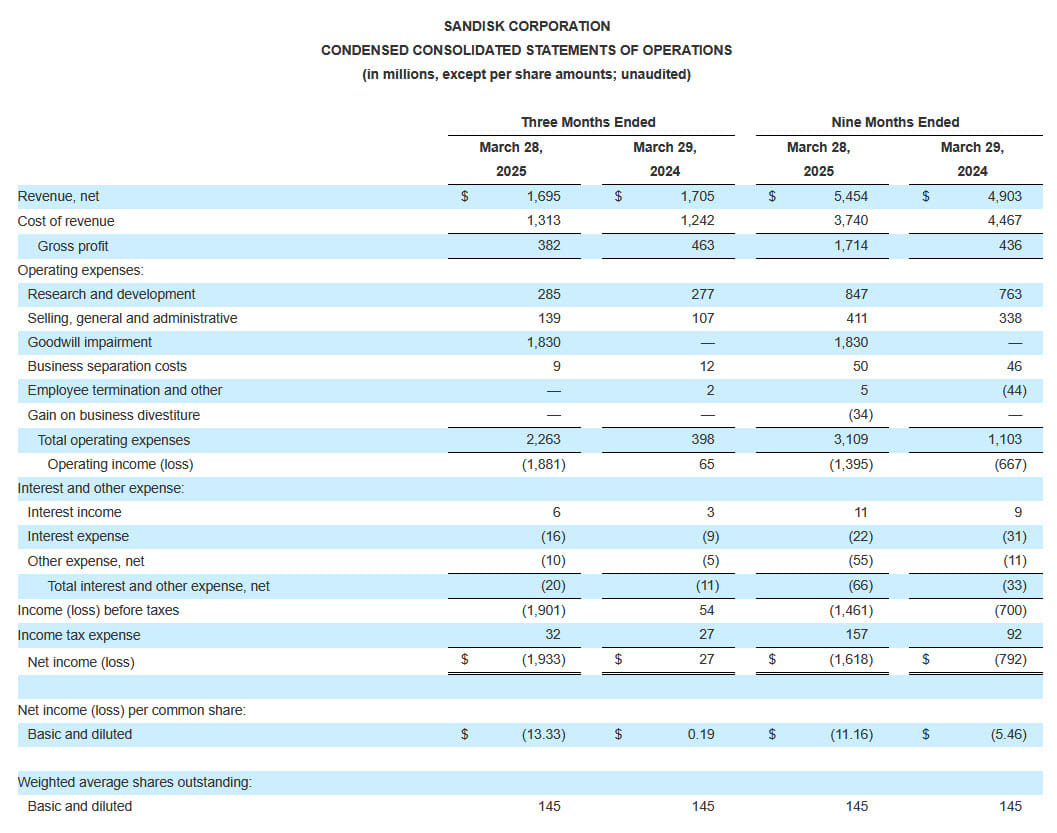
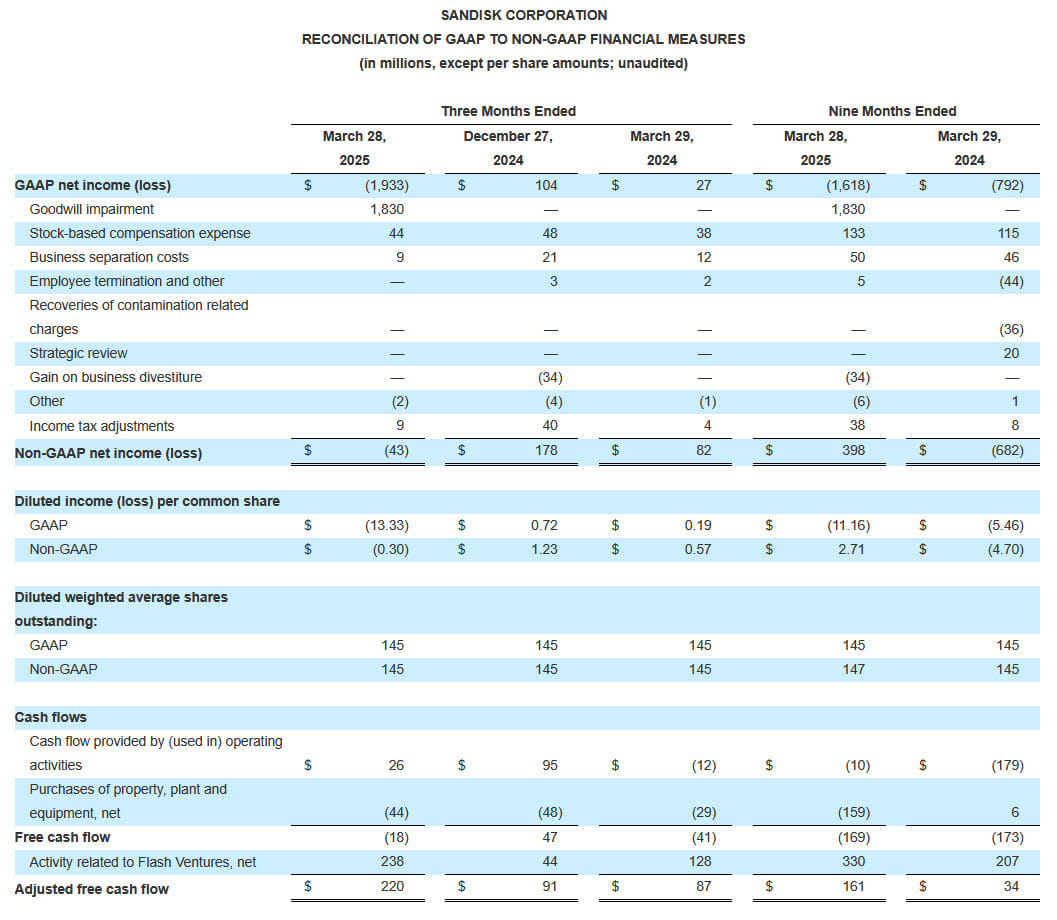
To supplement the condensed consolidated financial statements presented in accordance with GAAP, the table above sets forth Non-GAAP gross profit; Non-GAAP operating expenses; Non-GAAP operating income (loss); Non-GAAP interest and other expense, net; Non-GAAP income tax expense; Non-GAAP net income (loss); Non-GAAP diluted income (loss) per common share; Non-GAAP diluted weighted average shares outstanding; Free cash flow; and Adjusted free cash flow (collectively, the “Non-GAAP measures”). These Non-GAAP measures are not in accordance with, or alternatives for measures prepared in accordance with GAAP and may be different from similarly titled Non-GAAP measures used by other companies. The Company believes the presentation of these Non-GAAP measures, when shown in conjunction with the corresponding GAAP measures, provides useful information to investors for measuring the Company’s earnings performance and comparing it vs. prior periods. Specifically, the Company believes these Non-GAAP measures provide useful information to both management and investors as they exclude certain expenses, gains, and losses that the Company believes are not indicative of its core operating results or because they are consistent with the financial models and estimates published by many analysts who follow the Company and its peers. As discussed further below, these Non-GAAP measures exclude, as applicable, goodwill impairment, stock-based compensation expense, business separation costs, employee termination and other, recoveries on contamination related charges, expenses related to our strategic review, gain on business divestiture, other adjustments, and income tax adjustments. The Company believes these measures, along with the related reconciliations to the most directly comparable GAAP measures, provide additional detail and comparability for assessing the Company’s results. These Non-GAAP measures are some of the primary indicators management uses for assessing the Company’s performance and planning and forecasting future periods. These measures should be considered in addition to results prepared in accordance with GAAP, but should not be considered a substitute for, or superior to, GAAP results.
As described above, the Company excludes the following items from its Non-GAAP measures:
Goodwill impairment. After the completion of the separation, in the third quarter of fiscal 2025, the Company identified potential impairment indicators related to the trading price of the Company’s common stock and resulting market capitalization that warranted a quantitative impairment analysis of long-lived assets and goodwill. Management performed a quantitative impairment analysis and determined that the carrying value of the reporting unit exceeded its fair value, resulting in the recognition of a $1.8 billion impairment charge for the three and nine months ended March 28, 2025. The Company believes this charge does not reflect the Company’s operating results and is not indicative of the underlying performance of the business.
Stock-based compensation expense. Because of the variety of equity awards used by companies, the varying methodologies for determining stock-based compensation expense, the subjective assumptions involved in those determinations and the volatility in valuations that can be driven by market conditions outside the Company’s control, the Company believes excluding stock-based compensation expense enhances the ability of management and investors to understand and assess the underlying performance of the business over time and compare it vs. the Company’s peers, a majority of whom also exclude stock-based compensation expense from their Non-GAAP results.
Business separation costs. On October 30, 2023, Western Digital Corporation (“WDC”) announced that its board of directors (the “WDC Board of Directors”) authorized management to pursue a plan to separate the Company into an independent public company. The separation received final approval by the WDC Board of Directors and was completed on February 21, 2025. Prior to February 21, 2025, the Company was wholly-owned by WDC. As a result of the plan, the Company incurred separation and transition costs through the completion of the separation of the companies. The separation and transition costs are recorded within Business separation costs in the Condensed Consolidated Statements of Operations. The Company believes these charges do not reflect the Company’s operating results and that they are not indicative of the underlying results of its business.
Employee termination and other. From time to time, in order to realign the Company’s operations with anticipated market demand, the Company may terminate employees and/or restructure its operations. From time to time, the Company may also incur charges from the impairment of long-lived assets. In addition, the Company may record credits related to gains upon sale of property due to restructuring or reversals of charges recorded in prior periods as well as from taking actions to reduce the amount of capital invested in facilities, including the sale-leaseback of facilities. These charges or credits are inconsistent in amount and frequency, and the Company believes they are not indicative of the underlying performance of its business.
Recoveries of contamination related charges. In February 2022, a contamination of certain materials used in the Company’s manufacturing process occurred and affected production at Flash Ventures manufacturing facilities. The contamination resulted in scrapped inventory, rework costs, decontamination and other expenses needed to restore the facilities to normal capacity. During the second quarter of fiscal year 2024, the Company received insurance recoveries for losses from contamination-related charges. The charges and recoveries are inconsistent in amount and frequency, and the Company believes they are not part of the ongoing production operation of its business.
Strategic review. The Company incurred expenses associated with its review of potential strategic alternatives aimed at further optimizing the long-term value for stockholders. The Company believes these charges do not reflect the Company’s operating results and that they are not indicative of the underlying performance of its business.
Gain on business divestiture. In connection with the Company’s strategic decision to outsource the manufacturing of certain components and assemblies, on September 28, 2024, the Company completed the sale of 80% of its equity interest in one of its manufacturing subsidiaries. The transaction resulted in a discrete gain, which the Company believes it is not indicative of the underlying performance of its ongoing business operations.
Other adjustments. From time to time, the Company incurs charges or gains that the Company believes are not a part of the ongoing operation of its business. The resulting expense or benefit is inconsistent in amount and frequency.
Income tax adjustments. Income tax adjustments include the difference between income taxes based on a forecasted annual Non-GAAP tax rate and a forecasted annual GAAP tax rate as a result of the timing of certain Non-GAAP pre-tax adjustments. The income tax adjustments also include the re-measurement of certain unrecognized tax benefits primarily related to tax positions taken in prior quarters, including interest. These adjustments are excluded because the Company believes that they are not indicative of the underlying performance of its ongoing business.
Additionally, free cash flow is defined as cash flows provided by (used in) operating activities less purchases of property, plant and equipment, net, and adjusted free cash flow is defined as free cash flow plus the activity related to Flash Ventures, net. The Company considers free cash flow and adjusted free cash flow generated in any period to be useful indicators of cash that is available for strategic opportunities, including, among others, investing in the Company’s business, making strategic acquisitions, repaying debt and strengthening the balance sheet.








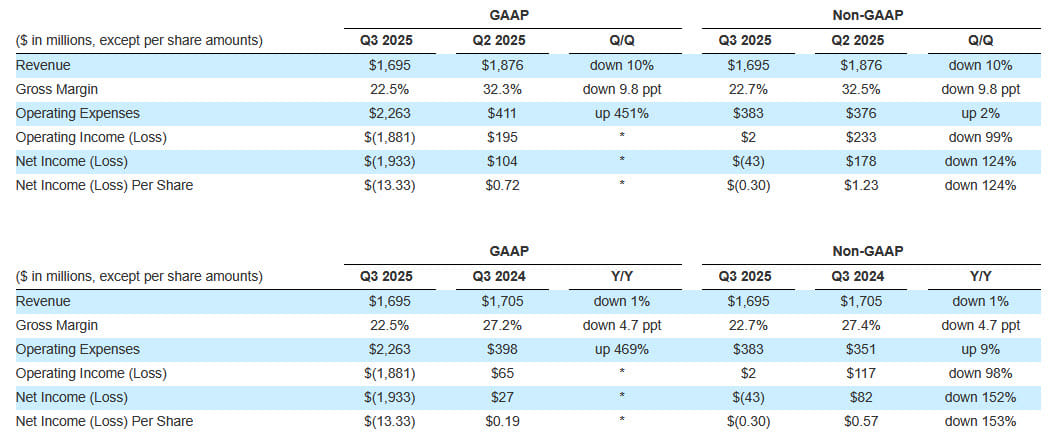


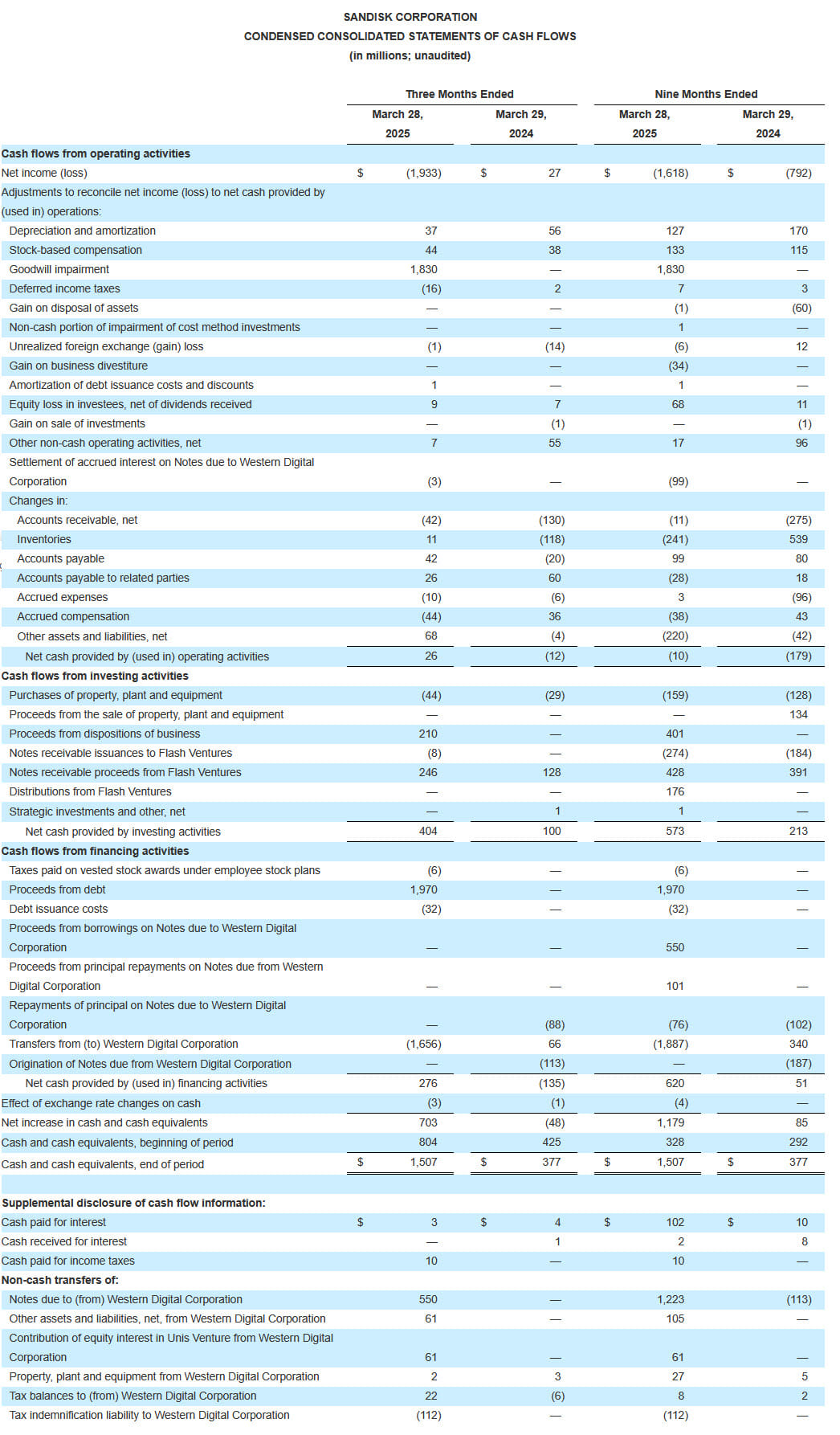
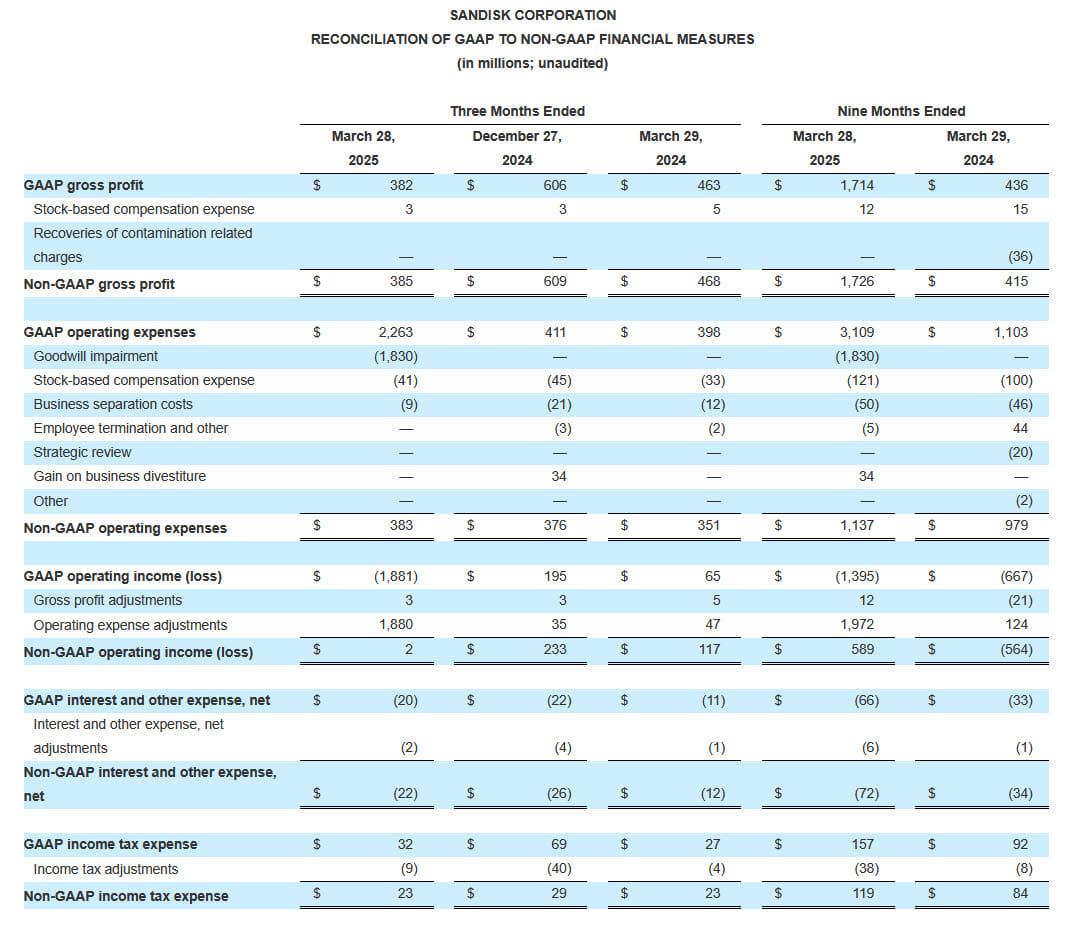






 Subscribe to our free daily newsletter
Subscribe to our free daily newsletter
